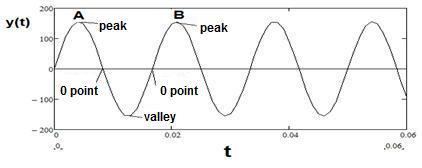

Incandescent lamp impact on vision and health

Figure 1 The voltage waveform across incandescent lamp; horizontal axis is time, vertical axis is voltage.
Since 1879, Thomas Edison invented the first commercially practical incandescent lamp (US patent 223,898). The lamp is connected to 220volt 50Hz AC or 110volt 60Hz AC power line. The voltage across the lamp is shown in Figure 1.
Incandescent Lamp Brings "flicker Light " with Low Frequency: The brightness of the lamp is proportional to the magnitude of voltage across the lamp. The brightness goes up to maximum when voltage reaches peak; the brightness drops down to minimum when voltage crosses 0 point.
For 110volt 60Hz, the brightness changes from brightness to darkness back and forth for 50 times per second. This kind of light is "flicker light " with low frequency.Pupils of the human eyes will contract in a bright environment and will dilate in a dark environment. In a second, pupils will contract and dilate 50 times with variation of the lamp brightness. So eyes constantly adjust the pupil and are very tired ultimately leading to the eye muscle loose. Then eyes cannot effectively regulate the pupils and lens thus myopia is caused.
Hospital of Nantong University in China found myopia can be induced by low frequency "flicker light" in B6 mice. Forty-five 28-day-old C57BL/6 (B6) mice were randomly assigned to three groups: control group, "flicker light" stimulation group and form deprivation (FD) group. Mice in the control group were raised under 250 lux illumination from 8:00 a.m. to 8:00 p.m. Mice in the "flicker light"group were raised under illumination with a duty cycle of 50% at a flash rate of 2 Hz from 8:00 a.m. to 8:00 p.m. for 6 weeks. After 6 weeks' exposure to "flicker light", the flicker light stimulation group became more myopic compared with the control group[1]
La Trobe University in Anstralia found low frequency temporal modulation of light promotes a myopic shift [2].
The Ohio State University found highly nearsighted people are at greater risk of several vision-threatening problems such as retinal detachments, choroidal atrophy, cataracts and glaucoma[3].
Duke University of Medical center found severe or high-grade myopia is a leading cause of blindness because of its associated ocular comorbidities of retinal detachment, macular choroidal degeneration, premature cataract, and glaucoma[4].
Uppsala University in Sweden research data suggest that near infrared radiation may cause cumulative damage in the ocular lens[5].
University of Texas at Austin found the 1300-nm ocular damage data have yielded unusual characteristics where continuous wave retinal damage was observed in rabbit models[6].
[1] Yu Y, Chen H, Tuo J, Zhu Y, Effects of flickering light on refraction and changes in eye axial length of C57BL/6 mice, Ophthalmic Res.2011;46(2):80-7.doi:10.1159/000323179. Epub 2011 Jan 26
[2] Crewther SG, Barutchu A, Murphy MJ, Low frequency temporal modulation of light promotes a myopic shift in refractive compensation to all spectacle lenses, Exp Eye Res. 2006 Aug;83(2):322-8. Epub 2006 Mar 31.
[3] Walline JJ, Lindsley K, Vedula SS, Cotter SA, Mutti DO, Twelker JD, Interventions to slow progression of myopia in children. Cochrane Database Syst Rev.2011 Dec 7; (12):CD004916.doi: 10.1002/14651858 .CD004916.pub3
[4] Hornbeak DM, Young TL, Myopia genetics: a review of current research and emerging trends, Curr Opin Ophthalmol. 2009 Sep;20(5):356-62. doi: 10.1097/ICU.0b013e32832f8040.
[5] Soderberg PG, Optical radiation and the eyes with special emphasis on children. Prog Biophys Mol Biol. 2011 Dec;107(3):389-92. doi: 10.1016/j.pbiomolbio.2011.09.009. Epub 2011 Sep 21.
[6] Vincelette RL, Welch AJ, Thomas RJ, Rockwell BA, Lund DJ, Thermal lensing in ocular media exposed to continuous-wave near-infrared radiation: the 1150-1350-nm region. J Biomed Opt.2008 Sep-Oct;13(5):054005.doi:10.1117/1.2978066